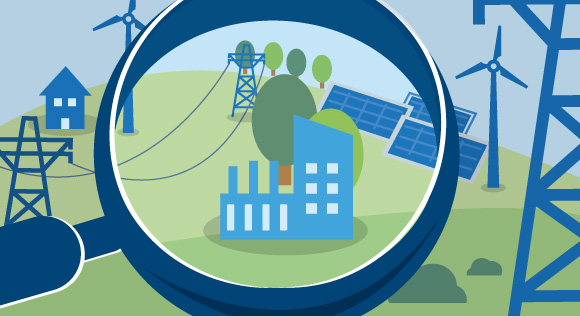What exactly is an ‘energy management system’?
Energy management is not as complicated as it sounds. It is actually very similar to what a football coach does. Read on to learn more.
 © BMWi
© BMWi
This is what it’s all about: by using an energy management system, large energy consumers can determine exactly how much energy they are using, identify ways in which they can reduce energy demand, improve energy efficiency and cut costs.
A football coach always wants his players to perform as well as they can. In order to achieve this, he analyses the strengths and weaknesses of each of his players, helps them improve through practice, and sometimes even takes a player off the pitch to replace him with a more effective one. In other words: the coach helps his team to be efficient and give their best performance.
This is exactly what an energy management system (EMS) does for industrial companies. Energy management systems analyse a company’s current energy consumption and show companies where they can use less energy, thereby helping them to continuously improve energy efficiency and reduce their costs without compromising their performance.
In practice this means that EMS identify peaks in demand and incorrect settings, compare how much energy a consumer should be using with how much that consumer is actually using, detect disruptions early on, optimise the entire energy infrastructure and help companies meet their reporting duties for sustainability.
Customised solutions help deliver the best results
By using an energy management system, companies are making energy conservation a corporate policy. Software solutions help companies keep track at all times of how much energy they are using. Hardware is needed to provide the software solution with the relevant consumption data and to guide energy consumers towards minimising their energy consumption. Beyond that, EMS can be used to adjust a company’s operational processes to make these more energy-efficient, for example in manufacturing, or by making optimal use of residual heat. Energy management systems need to take account of the specific circumstances in which a company operates – it therefore does not come as a surprise that a wide range of different energy-management products and services are available on the market.
EMS are not limited to use in industrial companies; they can also help commercial firms, municipalities, utilities and housing businesses considerably reduce both their energy consumption and their costs. By using an energy management system companies can reduce their energy consumption by as much a 30 per cent. The use of energy management systems certified under DIN EN ISO 50001 – the first international standard for energy management systems – is particularly recommended.
Germany is a global leader in the use of certified EMS, but there is room for more
Around 9,000 companies and public-sector institutions in Germany are already using an EMS certified under ISO 50001. Another 5,000 companies use other EMS. This means that Germany is the global leader on the use of certified EnMS. This means that Germany is a global leader in the use of certified EMS. However, considering the fact that there are more than 90,000 German companies with more than 50 employees, there still is a lot of potential that remains untapped. Not only in terms of reducing energy consumption, but also in terms of the climate as energy management systems can also help tackle climate change. The Federal Government is therefore providing funding for the acquisition and installation of measurement, monitoring and control technology, for sensor and energy-management software, and for training employees in the use of the software. Under the Energy Audits for SMEs programme, small and medium-sized companies can receive funding for having an energy expert advise them on the implementation and maintenance of an energy management system.

